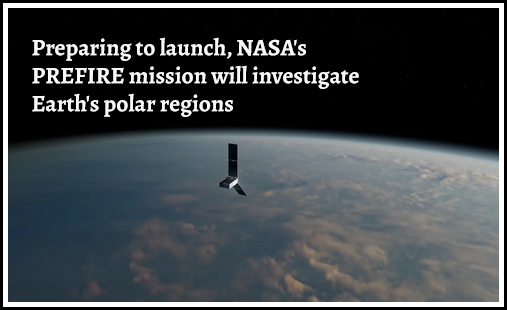NASA
Preparing to launch, NASA’s PREFIRE mission will investigate Earth’s polar regions
Published
1 month agoon

The principal objective of NASA’s PREFIRE mission is to examine the quantity of heat emitted into space from Earth’s polar regions and its influence on the Earth’s climate
Today, May 22, the Polar Radiant Energy in the Far-Infrared Experiment (PREFIRE), the newest mission of the National Aeronautics and Space Administration (Nasa), is scheduled to launch. Twin shoebox-sized climate satellites will be launched as part of this mission to investigate the Arctic and Antarctic.
The first cubesat, called “Ready, Aim, PREFIRE,” is expected to launch on May 22. The second, called “PREFIRE and ICE,” is expected to launch a few days later, according to a report by Space.com.
What goals does NASA have for the PREFIRE mission?
The PREFIRE mission’s main objective is to measure the amount of heat emitted into space by Earth’s polar regions and its effect on the planet’s climate. Fifty percent of the heat outputs in these frigid areas are at far-infrared wavelengths (longer than 15 micrometers).
According to NASA, little information is now available to researchers on the precise regions of the Arctic and Antarctic where this heat is being emitted. By offering comprehensive data on the efficiency with which snow and sea ice release far-infrared heat and the impact of clouds on this radiation, PREFIRE seeks to close this knowledge gap.
Every PREFIRE A thermal infrared spectrometer will be installed on CubeSat to monitor the amount of far-infrared radiation that is emitted into space by the Earth’s atmosphere and surface. This more affordable platform than a full-sized satellite is intended to address important inquiries concerning the far-infrared heat emissions from the poles.
Knowing about polar heat loss
Through the process of reflecting heat received at the tropics back into space, the polar regions play a crucial part in controlling Earth’s temperature. To understand why the Arctic has warmed more than twice the world average, it is crucial to develop an understanding of the heat loss mechanisms in the region, as only 40% of the energy departing from the Arctic has been carefully measured.
The observations of this heat exchange by PREFIRE will contribute to our knowledge of the consequences of polar ice loss for sea level rise and sea ice loss.
NASA’s PREFIRE satellites’ effects on climate models
To measure thermal infrared radiation, the CubeSats will be deployed in asynchronous, near-polar orbits that will allow them to crisscross over the Arctic and Antarctica.
By updating climate and ice models with this data, scientists will be able to more accurately predict changes in ice cover, weather patterns, and sea level as the planet warms.
The results of the mission will be available to researchers and the general public via NASA’s Atmospheric Science Data Center thanks to the public access to PREFIRE data.
Oversight of PREFIRE satellite systems
NASA and the University of Wisconsin-Madison are working together on the PREFIRE mission. The spectrometers and mission management are handled by NASA’s Jet Propulsion Laboratory, while Blue Canyon Technologies constructed the CubeSats.
The information gathered will be processed by the University of Wisconsin–Madison. NASA’s Launch Services Program awarded a contract to Venture-class Acquisition of Dedicated and Rideshare, which will see Rocket Lab launch both spacecraft.
Credent TV Editorial Team

You may like
-


Secrets of the Google Search algorithm disclosed by a leaker
-


There Was Another Strong Solar Storm Heading Toward Earth, Blackouts Possible
-


Google RealFill, an AI-powered generative image completion model, was spotted in a trademark listing
-


During Elon Musk’s visit, Tesla removes significant regulatory obstacles for self-driving cars in China
-


Google and Samsung confirm their collaboration for ‘exciting’ AI-powered experiences
-


WhatsApp Passkey Support is Available for iPhone Users: How to Set Up